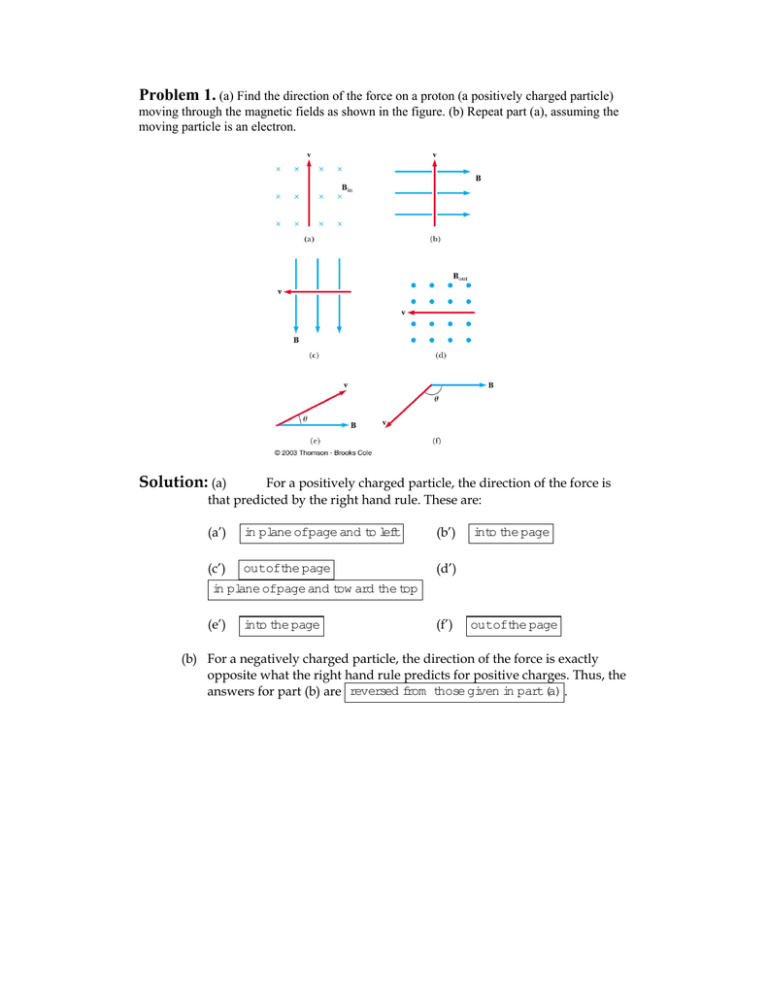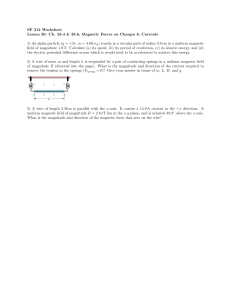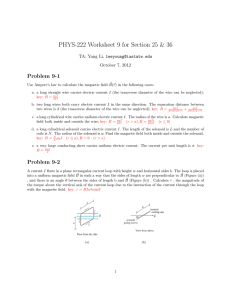Problems and solutions on Magnetism
advertisement

Problem 1. (a) Find the direction of the force on a proton (a positively charged particle) moving through the magnetic fields as shown in the figure. (b) Repeat part (a), assuming the moving particle is an electron. Solution: (a) For a positively charged particle, the direction of the force is that predicted by the right hand rule. These are: (a’) in plane ofpage and to left (b’) (c’) outofthe page (d’) into the page in plane ofpage and tow ard the top (e’) into the page (f’) outofthe page (b) For a negatively charged particle, the direction of the force is exactly opposite what the right hand rule predicts for positive charges. Thus, the answers for part (b) are reversed from those given in part(a) . Problem 2. Find the direction of the magnetic field acting on the positively charged particle moving in the various situations shown in the figure, if the direction of the magnetic force acting on it is as indicated. Solution: Since the particle is positively charged, use the right hand rule. In this case, start with the thumb of the right hand in the direction of v and the palm facing the direction of F. The fingers will point in the direction of B. The results are (a) into the page (b) tow ard the right (c) tow ard bottom ofpage Problem 3. Determine the initial direction of the deflection of charged particles as they enter the magnetic fields shown in the figure. Solution: Hold the right hand with the thumb in the direction of v and the fingers in the direction of B. The palm will the face the direction of the force (and hence the deflection) if the particle has a positive charge. The results are (a) tow ard top ofpage (b) outofthe page , since the charge is (d) into the page negative. (c) zero force Problem 4. A proton travels with a speed of 3.0 × 106 m/s at an angle of 37° with the direction of a magnetic field of 0.30 T in the +y direction. What are (a) the magnitude of the magnetic force on the proton and (b) the proton’s acceleration? Solution: (a) F = qvB sin θ ( ) )( = 1.60 × 10−19 C 3.0 × 106 m s ( 0.30 T ) sin ( 37° ) = 8.7 × 10−14 N (b) a = F 8.7 × 10−14 N = = 5.2 × 1013 m s2 m 1.67 × 10-27 kg Problem 5. A proton moves perpendicularly to a uniform magnetic field B at 1.0 × 107 m/s and experiences an acceleration of 2.0 × 1013 m/s2 in the +x direction when its velocity is in the +z direction. Determine the magnitude and direction of the field. −27 13 2 F m a 1.67 × 10 kg 2.0 × 10 m s Solution: B = = = = 0.021 T qv qv 1.60 × 10−19 C 1.0 × 107 m s ( ( )( )( ) ) The right hand rule shows that B must be in the -y direction to yield a force in the +x direction when v is in the +z direction. Problem 6. A current I = 15 A is directed along the positive x axis and perpendicularly to a magnetic field. The conductor experiences a magnetic force per unit length of 0.12 N/m in the negative y direction. Calculate the magnitude and direction of the magnetic field in the region through which the current passes. Solution: From F = BIL sinθ , the magnetic field is B= FL 0.12 N m = = 8.0 × 10−3 T Isin θ (15 A ) sin 90° The direction of B must be the + z direction to have F in the –y direction when I is in the +x direction. Problem 7. A wire carries a steady current of 2.40 A. A straight section of the wire is 0.750 m long and lies along the x axis within a uniform magnetic field of magnitude 1.60 T in the positive z direction. If the current is in the + x direction, what is the magnetic force on the section of wire? Solution: The magnitude of the force is F = BIL sin θ = (1.60 T ) ( 2.40 A ) ( 0.750 m ) sin ( 90.0°) = 2.88 N and, from the right hand rule, the force is in the − y direction . Problem 8. A wire carries a current of 10.0 A in a direction that makes an angle of 30.0° with the direction of a magnetic field of strength 0.300 T. Find the magnetic force on a 5.00m length of the wire. Solution: F = BIL sinθ = ( 0.300 T )(10.0 A )( 5.00 m ) sin ( 30.0°) = 7.50 N Problem 9. A wire with a mass per unit length of 1.00 g/cm is placed on a horizontal surface with a coefficient of friction of 0.200. The wire carries a current of 1.50 A eastward and moves horizontally to the north. What are the magnitude and the direction of the smallest vertical magnetic field that enables the wire to move in this fashion? Solution: For minimum field, B should be perpendicular to the wire. If the force is to be northward, the field must be directed dow nw ard . To keep the wire moving, the magnitude of the magnetic force must equal that of the kinetic friction force. Thus, BIL sin90° = μ k ( m g) , or B= μk ( m L) g ( 0.200) (1.00 g cm ) ( 9.80 m s2 ) ⎛ 1 kg ⎞ ⎛ 102 m ⎞ = ⎜⎝ 103 g ⎟⎠ ⎜⎝ 1 m ⎟⎠ = 0.131 T Isin 90° (1.50 A )(1.00) Problem 10. A conductor suspended by two flexible wires as shown in the figure has a mass per unit length of 0.040 0 kg/m. What current must exist in the conductor for the tension in the supporting wires to be zero when the magnetic field is 3.60 T into the page? What is the required direction for the current? Solution: To have zero tension in the wires, the magnetic force per unit length must be directed upward and equal to the weight per unit length of the conductor. Thus, Fm L = B I= mg , or L Bin ( m L) g = ( 0.040 kg m ) ( 9.80 m I= B 3.60 T s2 )= 0.109 A From the right hand rule, the current must be to the right if the force is to be upward when the magnetic field is into the page. Problem 11. A thin, horizontal copper rod is 1.00 m long and has a mass of 50.0 g. What is the minimum current in the rod that can cause it to float in a horizontal magnetic field of 2.00 T? Solution: If the rod is to float, the magnetic force must be directed upward and have a magnitude equal to the weight of the rod. Thus, BIL sin θ = m g , or I= mg B L sin θ For minimum current, sin θ = 1 giving m g ( 0.0500 kg) ( 9.80 m s ) = = 0.245 A Im in = BL ( 2.00 T ) (1.00 m ) 2 Problem 12. In the figure , the cube is 40.0 cm on each edge. Four straight segments of wire—ab, bc, cd, and da—form a closed loop that carries a current I = 5.00 A, in the direction shown. A uniform magnetic field of magnitude B = 0.020 0 T is in the positive y direction. Determine the magnitude and direction of the magnetic force on each segment. Solution:For each segment, the magnitude of the force is given by F = BIL sinθ and the direction is given by the right hand rule. The results of applying these to each of the four segments are summarized below. Segment L (m) θ F (N) Direction ab 0.400 180° 0 _ bc 0.400 90.0° 0.0400 negative x cd 0.400 2 45.0° 0.0400 negative z 0.0566 parallel to x-z plane at 45° to both +x and +z directions da 0.400 2 90.0° y d a z I b c B x Problem 13. Find the direction of the current in the wire as shown in the figure that would produce a magnetic field directed as shown, in each case. Solution: Imagine grasping the conductor with the right hand so the fingers curl around the conductor in the direction of the magnetic field. The thumb then points along the conductor in the direction of the current. The results are (a) (b) tow ard the left outofpage (c) low er leftto upper right Problem 14. At what distance from a long, straight wire carrying a current of 5.0 A is the magnetic field due to the wire equal to the strength of Earth’s field, approximately 5.0 × 10–5 T? Solution: From B = μ0I 2π r , the required distance is μ I ( 4π × 10 T ⋅ m A ) ( 5.0 A ) = 2.0 × 10−2 m = 2.0 cm r= 0 = 2π B 2π ( 5.0 × 10−5 T ) -7 Problem 15. The two wires shown in the figure carry currents of 5.00 A in opposite directions and are separated by 10.0 cm. Find the direction and magnitude of the net magnetic field (a) at a point midway between the wires, (b) at point P1 (10.0 cm to the right of the wire on the right), and (c) at point P2 (20.0 cm to the left of the wire on the left). Solution: Assume that the wire on the right is wire 1 and that on the left is wire 2. Also, choose the positive direction for the magnetic field to be out of the page and negative into the page. (a) At the point half way between the two wires, ⎡ μ0I1 μ0I2 ⎤ μ0 + ( I1 + I2 ) ⎥=− 2π r ⎣ 2π r1 2π r2 ⎦ Bnet = − B1 − B2 = − ⎢ ( 4π × 10 T ⋅ m A ) (10.0 A ) = − 4.00 × 10 2π ( 5.00 × 10 m ) −7 =− −5 -2 T or Bnet = 40.0 μT into the page Bnet = + B1 − B2 = (b) At point P1 , ( 4π × 10 = −7 Bnet ( 4π × 10 −7 Bnet = ) T ⋅ m A ⎡ 5.00 A 5.00 A ⎤ − = 5.00 μT outofpage ⎢ 2π ⎣ 0.100 m 0.200 m ⎥⎦ Bnet = −B1 + B2 = (c) At point P2 , μ0 ⎡ I1 I2 ⎤ ⎢ − ⎥ 2π ⎣ r1 r2 ⎦ ) μ0 ⎡ I1 I2 ⎤ ⎢− + ⎥ 2π ⎣ r1 r2 ⎦ T ⋅ m A ⎡ 5.00 A 5.00 A ⎤ ⎢⎣ − 0.300 m + 0.200 m ⎥⎦ 2π = 1.67 μT outofpage Problem 16. A wire carries a 7.00-A current along the x axis and another wire carries a 6.00-A current along the y axis as shown in the figure. What is the magnetic field at point P located at x = 4.00 m, y = 3.00 m? Solution: Call the wire along the x axis wire 1 and the other wire 2. Also, choose the positive direction for the magnetic fields at point P to be out of the page. At point P, Bnet = + B1 − B2 = ( 4π × 10 −7 Bnet = or μ0I1 μ0I2 μ0 ⎛ I1 I2 ⎞ − = − , 2π r1 2π r2 2π ⎜⎝ r1 r2 ⎟⎠ ) T ⋅ m A ⎛ 7.00 A 6.00 A ⎞ −7 − ⎜⎝ ⎟ = +1.67 × 10 T 2π 3.00 m 4.00 m ⎠ Bnet = 0.167 μT outofthe page Problem 17. Two parallel wires are 10.0 cm apart, and each carries a current of 10.0 A. (a) If the currents are in the same direction, find the force per unit length exerted by one of the wires on the other. Are the wires attracted or repelled? (b) Repeat the problem with the currents in opposite directions. Solution: ( 4π × 10 T ⋅ m A ) (10.0 A ) F μ0II 1 2 = = 2π ( 0.100 m ) L 2π d −7 (a) = 2.00 × 10−4 N m 2 ( attraction) (b) The magnitude remains the same as calculated in (a), but the wires are repelled. Thus, F = 2.00 × 10−4 N m L ( repulsion) Problem 18. A wire with a weight per unit length of 0.080 N/m is suspended directly above a second wire. The top wire carries a current of 30.0 A, and the bottom wire carries a current of 60.0 A. Find the distance of separation between the wires so that the top wire will be held in place by magnetic repulsion. Solution: In order for the system to be in equilibrium, the repulsive magnetic force per unit length on the top wire must equal the weight per unit length of this wire. Thus, F μ0II 1 2 = = 0.080 N m , and the distance between the wires will be L 2π d d= μ0II 1 2 2π ( 0.080 N m ( 4π × 10 −7 ) = ) T ⋅ m A ( 60.0 A )( 30.0 A ) 2π ( 0.080 N m ) = 4.5 × 10−3 m = 4.5 m m Problem 19. In the following figure, the current in the long, straight wire is I1 = 5.00 A, and the wire lies in the plane of the rectangular loop, which carries 10.0 A. The dimensions are c = 0.100 m, a = 0.150 m, and A = 0.450 m. Find the magnitude and direction of the net force exerted by the magnetic field due to the straight wire on the loop. Solution: The magnetic forces exerted on the top and bottom segments of the rectangular loop are equal in magnitude and opposite in direction. Thus, these forces cancel and we only need consider the sum of the forces exerted on the right and left sides of the loop. Choosing to the left (toward the long, straight wire) as the positive direction, the sum of these two forces is Fnet = + μ0II μ II A μ II A ⎛ 1 1 ⎞ 1 2A − 012 = 012 ⎜ − ⎟, 2π c 2π ( c+ a) 2π ⎝ c c+ a⎠ ( 4π × 10 = −7 or Fnet ) T ⋅ m A ( 5.00 A )(10.0 A )( 0.450 m ) ⎛ 1 1 ⎞ − ⎜⎝ ⎟ 2π 0.100 m 0.250 m ⎠ = + 2.70 × 10−5 N = 2.70 × 10−5 N to the left Problem 20. What current is required in the windings of a long solenoid that has 1 000 turns uniformly distributed over a length of 0.400 m in order to produce a magnetic field of magnitude 1.00 × 10–4 T at the center of the solenoid? Solution: The magnetic field inside a long solenoid is B = μ0nI= μ0 ⎛⎜⎝ N⎞ ⎟ I. Thus, L⎠ the required current is (1.00 × 10 T) ( 0.400 m ) = 3.18 × 10−2 A = 31.8 m A BL = μ0N ( 4π × 10-7 T ⋅ m A ) (1000) −4 I= Problem 21. It is desired to construct a solenoid that has a resistance of 5.00 Ω and that produces a magnetic field at its center of 4.00 × 10–2 T when it carries a current of 4.00 A. The solenoid is to be constructed from copper wire having a diameter of 0.500 mm. If the radius of the solenoid is to be 1.00 cm, determine (a) the number of turns of wire needed and (b) the length the solenoid should have. Solution: (a) From R = ρL A , the required length of wire to be used is −3 ⎡ ⎤ R ⋅ A ( 5.00 Ω) ⎣π ( 0.500 × 10 m ) 4⎦ = = 57.7 m L= 1.70 × 10−8 Ω ⋅ m ρ 2 The total number of turns on the solenoid (i.e., the number of times this length of wire will go around a 1.00 cm radius cylinder) is N = L 57.7 m = = 919 2π r 2π ( 1.00 × 10−2 m ) (b) From B = μ0nI, the number of turns per unit length on the solenoid is n= B 4.00 × 10−2 T = = 7.96 × 103 turns m μ0I ( 4π × 10-7 T ⋅ m A ) ( 4.00 A ) Thus, the required length of the solenoid is N 919 turns = = 0.115 m = 11.5 cm n 7.96 × 103 turns m




